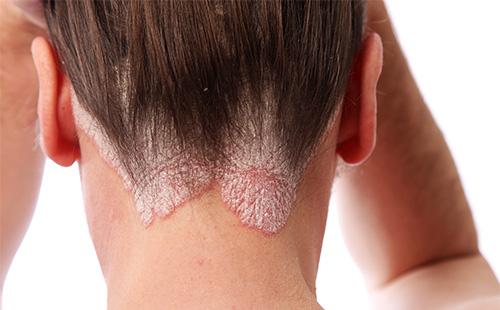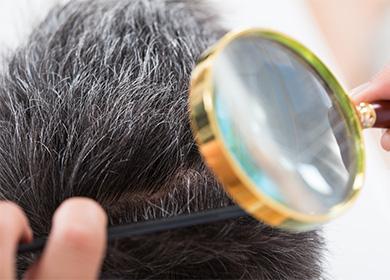The content of the article
This disease has been known since the time of Hippocrates. It was he who described the symptoms. In particular, he indicated rashes localized in the scalp. On average, this pathology occurs in 2-7% of the total population. It can occur at any age, even in children from four months. The involvement of the scalp with psoriasis is observed in 50-80% of patients. In the world 125 million people suffer from this form of the disease.
The reasons
The exact reasons for the appearance of rashes have not yet been established by scientists. There is an assumption about the genetic nature of the pathology, when, under the influence of environmental factors, the manifestation of symptoms occurs. A hereditary predisposition is confirmed by the fact that children whose father or mother suffer from psoriasis have similar health problems in 14% of cases. If this pathology is diagnosed in both parents, then the risk of its occurrence in the child increases to 40%.
According to most dermatologists, psoriasis is a chronic dermatosis, the mechanism of occurrence of which is due to autoimmune processes in the body. This is confirmed by the presence of immune complexes in the blood of patients, especially during the progression of rashes. Moreover, such complexes can be found not only on the scalp, but also in other organs and systems: kidneys, heart and blood vessels, liver, joints.
Symptoms
A characteristic manifestation of the pathology is the formation of psoriatic reddish plaques. Damage to the scalp is most often found in young patients, adolescents. It can be combined with other rashes (for example, on the limbs or trunk) or it can be the only symptom.
The disease is non-contagious and non-dangerous, but creates psychological problems for the patient, especially with a large lesion area. Rashes look unaesthetic: flat inflammatory papules, which have clearly defined borders and a rounded shape. And on the rough surface there are loose silvery scales that can easily be scraped off.
Initially, the disease manifests itself in the form of small papules - 1-2 mm. Subsequently, they increase in size and can reach a diameter of 1-3 cm. Sometimes such formations merge, forming plaques up to 10 cm or more.
Most often, rashes are localized at the border of hair growth in the occipital part and in the temples. Their appearance is accompanied by itching, hair loss. The scales exfoliate, resembling dandruff in appearance. (Sometimes pathology hides behind a mask seborrhea) This is especially noticeable on dark clothes. All this creates a certain psychological discomfort for the patient. As a result, itching intensifies on nerve soil, which leads to additional trauma to the plaques.
The following stages of the development of pathology are distinguished:
- manifestation and progression - plaques appear, their gradual growth occurs;
- stationary period - rashes remain stable in size;
- remission - gradual disappearance of plaques.
After the plaques disappear, light areas of the skin may remain in their place for some time. Less often, on the contrary, areas of hyperpigmentation (darkening) are visible. Psoriasis of the head is characterized by the presence of so-called “on-duty” rashes, when even during remission one or more small plaques remain.
The severity of manifestations of the disease is evaluated according to the international PASI scale. It takes into account the prevalence of rashes and their size, the nature of the inflammatory process. The following forms are distinguished:
- index less than 15 - light form;
- index over 15 - severe form.
There are also three degrees of severity:
- light - less than 50% of the scalp is affected, there is slight redness, dandruff and itching;
- moderate - the disease also affects less than 50% of the scalp, but redness, dandruff and itching are more pronounced;
- heavy- more than 50% of the head is affected, redness, dandruff and itching are expressed.
Diagnostics
The disease is determined by the presence of characteristic rashes. In some cases, microscopic examination of plaques may be necessary. Relatively rarely, a biopsy of the affected areas is performed. As can be seen from the table, the disease is important to distinguish from some other pathologies.
Table - Differential Diagnostics
| Disease | Difference from psoriasis |
|---|---|
| Seborrhea | - Rashes are limited to the scalp and do not go beyond the frontal line of hair; - lesions of smaller size and severity; - no changes in other parts of the body |
| Atopic eczema of the head | - Accompanied by severe itching; - there are scratches from scratching; - the size of the rashes is less pronounced; - sometimes accompanied by bacterial superinfection; - rashes can be detected in other parts of the body |
Treatment
Therapy depends on the severity of the process. Of the systemic medicines used:
- detoxification;
- antihistamines;
- retinoids;
- hepatoprotectors;
- cytostatics;
- immunosuppressants;
- glucocorticoids.
A prerequisite for treatment is the use of local drugs. Again, their choice depends on the degree of prevalence and stage of psoriasis. So, for example, at the initial stage, when there is a progression of rashes, most dermatologists recommend the use of glucocorticoid drugs of local action and moisturizing cosmetics. At the stage of stabilization of the process, it is enough to provide adequate care with the use of anti-inflammatory, keratolytic or moisturizing drugs.
Basic care
To improve the condition of the scalp it is better to use special shampoos with emollient and cleansing effects. They include urea, sulfur and salicylic acid. Examples:
- Oliprox;
- Babybene
- Ducray Kertyol PSO;
- Sorion.
Patients especially note the effectiveness of the BabyBene gel. It is applied to the scalp and moistened with water. This can be done at night. In the morning, along with the preparation, scaly layers are also removed. If necessary, treatment can be repeated.
From domestic preparations, the Emolium line is recommended. It includes shampoo and a special emulsion with softening and moisturizing effects. This is due to the constituents of linolenic acid, urea, shea butter and macadamia. These funds can be used for basic daily care.
With a mild form of pathology, regular use of a special shampoo is often enough to control the problem. The pharmacy has a huge amount of such cosmetics. They are carefully applied to wet hair, lightly massage the skin. Then you can leave the product for several minutes, then rinse. Some of these drugs are equipped with a special nebulizer or pipette, which greatly facilitates their use. Other products can be applied to dry scalp and then left to act for several hours, preferably overnight. After the tool works, it is washed off.
Conventional dandruff shampoos can also be used.However, only occasionally. Despite the fact that they slightly improve the condition, with prolonged use, the skin is too dry. The best option is to use neutral shampoos that do not irritate the skin.
It is especially important not to over irritate the skin, because it can aggravate the symptoms. In addition, when caring for hair, you need to be careful not to injure the skin, even if sometimes the rashes are very itchy. Women should avoid styling, it is better to refuse a hot hair dryer, do not use varnishes and sprays.
Anti-inflammatory measures
After cleansing the skin and removing scaly deposits, the goal of treatment is to eliminate the effects of dermatitis. It is carried out using topical cortisone preparations and combined medicines.
The use of glucocorticoids is possible in various dosage forms: emulsion, shampoo or spray. The glucocorticoids used for this purpose have different strengths (class). For example, apply:
- clobetasol- class IV;
- betamethasone valerate - class III;
- mometasone furoate - class III.
Cortisone preparations can not be used for more than four to six weeks: the active ingredient makes the skin thinner and more sensitive, it becomes susceptible to infections.
A combination of betamethasone (class III) with a vitamin D3 analogue, calcipotriol, is often used. There are also drugs containing only calcipotriol. For example, Tacalcitol. It is suitable for use over a long period (up to one year).
Preparations with dithranol (cignolin or anthralin) are often used in dermatological practice. The substance has been known since 1916 and is considered effective in local antipsoriatic therapy. It has an anti-inflammatory effect due to a decrease in immune complexes, slows down the rapid proliferation of skin cells characteristic of psoriasis, improves the differentiation of the cellular composition of the dermis. It is important that against the background of the use of this drug, atrophy of the skin is not observed. The problem is that the substance oxidizes to a brownish-blackish color upon contact with oxygen and creates staining zones on contact objects and skin. To treat psoriasis of the head, it is applied for a short period of time (minute therapy) and then washed off.
Help restore hair tar shampoos. They also reduce the severity and size of the rashes. Such cosmetics can be used to wash your hair in courses.

Local therapy regimen
Schematically, the main stages of the local therapy of psoriasis on the head are as follows.
- Skin cleansing. Apply BabyBene Gel. Preferred overnight use. Reusable.
- Hormones. One-component glucocorticoids are used: Clarelux, Clobex, Deflatop, Monovo emulsion. As well as drugs based on glucocorticoid and vitamin D3: Daivonex gel.
- Non-hormonal therapy. Use dithranol. Prescription: ditranol (0.25% or 0.5%), salicylic acid (5%), Silix oil (up to 100 ml). Apply using disposable gloves. They recommend starting with an active substance concentration of 0.25%. The starting time of the procedure is ten minutes. Then every three days increase the application time by five minutes. And so on until 30 minutes. If the symptoms do not completely disappear, then the concentration of ditranol is increased to 0.5%.
- Means with tar. A 4% tar solution (shampoo) is used.
- Phototherapy. Narrow-spectrum type B ultraviolet using a light comb.
Systemic medicines
They are prescribed only in cases where local treatment and light therapy did not give the desired effect. Or in severe cases of the disease. Drugs with proven effectiveness are listed.
- "Methotrexate." May lead to significant regression of scaly rashes four to eight weeks after initiation of therapy. It is believed that the active ingredient of this drug affects the immune system and slows the excessive growth of skin cells. However, often after drug withdrawal, new foci appear, often resistant to therapy. In addition, Methotrexate has many side effects. In particular, it has a damaging effect on kidney tissue.
- "Cyclosporin A". It has been proven that the drug is effective in all forms of psoriasis. It is one of the immunosuppressants that suppresses the function of the immune system. However, it also causes many serious complications. For example, damage to the gastrointestinal tract or renal failure.
- Biologically active proteins. These are artificially synthesized proteins that are identical to those in the human body. Rarely provoke adverse reactions or allergies. Medicines based on them ("Infliximab", "Efalizumab") are relatively new, there are no long-term studies regarding them. Their cost is high, so they are prescribed to patients who are resistant to therapy with standard drugs.
Do not self-medicate. Improper use of drugs, including expensive ones, can not only not improve the condition, but also cause an exacerbation. At the same time, the treatment regimen optimally selected by the doctor based on professional experience allows in many cases to reduce the symptoms of pathology and significantly extend remission.

